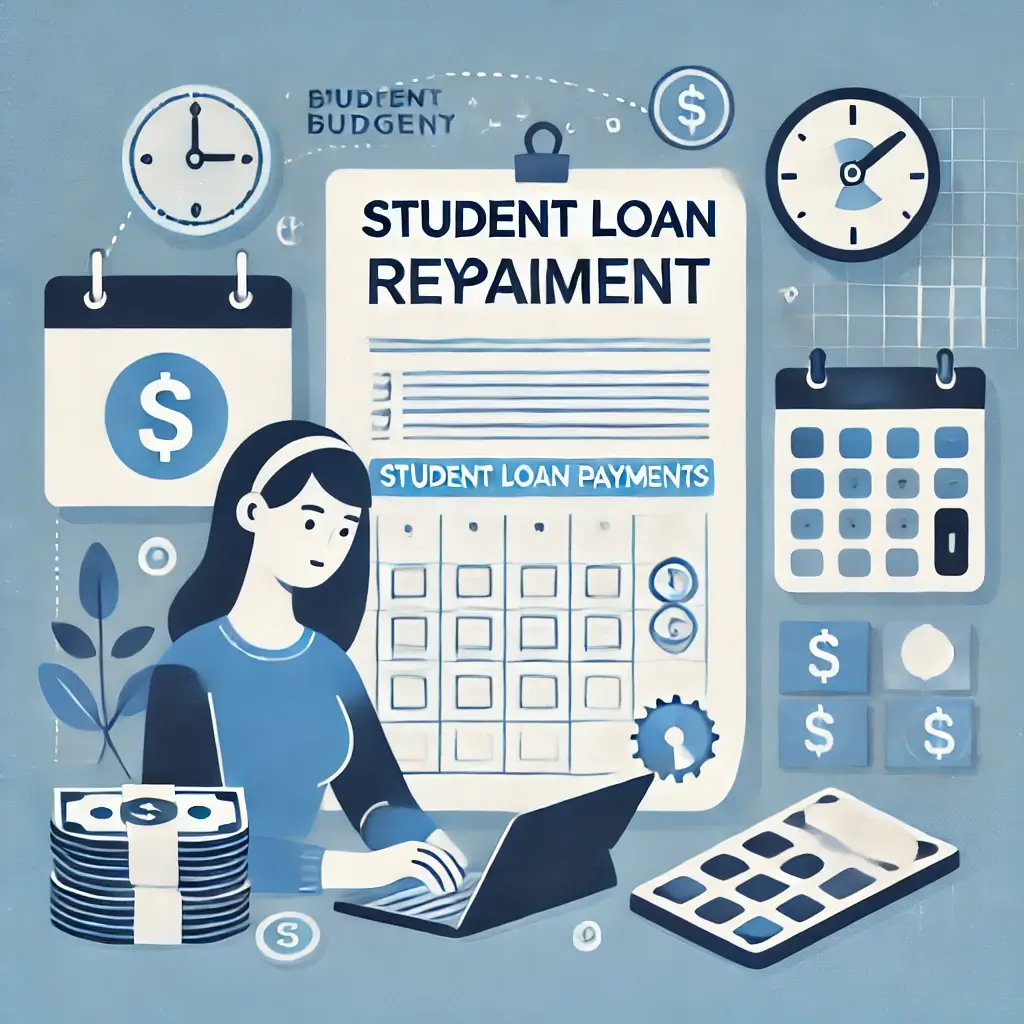Paying off student loans can feel overwhelming, but with the right strategy, you can manage your debt and achieve financial freedom faster. Whether you’re just starting repayment or looking for ways to accelerate the process, this guide will walk you through effective strategies on How to Pay Off Student Loans efficiently. We’ll cover budgeting, repayment plans, loan forgiveness programs, refinancing options, and more.
1. Understand Your Student Loans
The first step in paying off student loans is understanding what you owe. Knowing the type of loans, interest rates, and repayment terms is essential for developing a repayment strategy.
1.1 Federal vs. Private Loans
- Federal Loans: These loans come with benefits such as fixed interest rates, income-driven repayment options, and eligibility for forgiveness programs.
- Private Loans: Typically have higher interest rates and fewer borrower protections. Private loan repayment is less flexible but can sometimes be refinanced to secure a lower rate.
1.2 Loan Details to Know
- Interest Rates: Federal loans usually have lower, fixed interest rates, while private loans often have variable rates that can increase over time.
- Loan Balance: Know the total amount you owe, as well as your monthly payment obligations.
- Loan Servicer: Federal loans are serviced by different companies (e.g., Navient, FedLoan), so it’s important to know which company manages your loans.
2. Choose the Right Repayment Plan
Federal loans offer a variety of repayment plans to fit different financial situations. Selecting the right repayment plan is key to managing your debt effectively.
2.1 Standard Repayment Plan
The Standard Repayment Plan sets fixed monthly payments over 10 years. It’s the fastest and most cost-effective way to pay off loans, as it minimizes interest costs.
- Best For Borrowers who can afford higher monthly payments and want to pay off loans quickly.
2.2 Graduated Repayment Plan
The Graduated Repayment Plan starts with lower payments that increase every two years, making it easier to start paying loans early in your career.
- Best For: Borrowers expect their income to increase steadily over time.
2.3 Income-Driven Repayment Plans
Income-Driven Repayment (IDR) Plans calculate monthly payments based on your income and family size. These plans include:
- Income-Based Repayment (IBR)
- Pay As You Earn (PAYE)
- Revised Pay As You Earn (REPAYE)
- Income-contingent repayment (ICR)
Payments under IDR plans are typically lower, but these plans extend the repayment period to 20 or 25 years, increasing the total interest paid. However, any remaining balance after the repayment period can be forgiven.
- Best For: Borrowers with limited income or high loan balances relative to income.
3. Budget for Loan Repayment
Creating a budget that prioritizes your student loans can help you stay on track and pay off debt faster. Here’s how to incorporate your student loans into your financial plan.
3.1 Track Income and Expenses
Start by tracking your income and expenses to see how much you can afford to put toward your student loans each month. List all sources of income and create a breakdown of your fixed and variable expenses, such as rent, groceries, and transportation.
3.2 Cut Unnecessary Costs
Look for areas where you can cut expenses. Reducing discretionary spending on things like dining out, entertainment, or subscription services can free up extra funds for loan repayment.
3.3 Automate Your Payments
Set up automatic payments with your loan servicer. Many lenders offer a 0.25% interest rate reduction if you enroll in autopay, saving you money over the life of the loan.

4. Pay More Than the Minimum Payment
One of the most effective ways to pay off student loans faster is by making extra payments. Here’s how paying more than the minimum can save you money in the long run.
4.1 Apply Payments to Principal
When you make extra payments, be sure to specify that the additional amount should go toward the principal balance, not just interest. Reducing your principal balance decreases the amount of interest you’ll pay over time.
4.2 Make Biweekly Payments
Instead of making one monthly payment, consider making biweekly payments. By paying half your monthly amount every two weeks, you’ll make 26 payments per year instead of 12, which can significantly reduce your loan term.
5. Explore Loan Forgiveness Programs
For borrowers with federal loans, there are several loan forgiveness programs available that can eliminate part or all of your loan balance after meeting specific requirements.
5.1 Public Service Loan Forgiveness (PSLF)
PSLF forgives the remaining balance on your federal loans after you’ve made 120 qualifying monthly payments while working full-time for a government or nonprofit organization.
- Eligibility: You must work in a qualifying public service job and make payments under an income-driven repayment plan.
5.2 Teacher Loan Forgiveness
Teachers who work in low-income schools or educational service agencies may qualify for up to $17,500 in loan forgiveness through the Teacher Loan Forgiveness program.
- Eligibility: Must work full-time for five consecutive years in a qualifying school.
5.3 Income-Driven Repayment Forgiveness
If you’re enrolled in an income-driven repayment plan, any remaining balance after 20 or 25 years of qualifying payments is forgiven. This option is available for borrowers with high debt relative to their income.
6. Refinance Your Student Loans
Refinancing is a popular strategy for lowering interest rates and simplifying repayment, especially for private loans. Here’s how to know if refinancing is the right option for you.
6.1 Benefits of Refinancing
- Lower Interest Rates: Refinancing can secure a lower interest rate, which reduces the total cost of your loan.
- Consolidate Loans: You can combine multiple loans into one, making it easier to manage your payments.
- Fixed or Variable Rates: Choose between fixed and variable interest rates based on your financial situation.
6.2 When to Refinance
Refinancing is a good option if you have:
- Good Credit: A higher credit score can qualify you for lower interest rates.
- Stable Income: Lenders will want to see that you have a reliable income to make payments.
- Private Loans: Refinancing is especially beneficial for private loans with high interest rates.
Note: Refinancing federal loans into a private loan means losing access to federal protections, such as income-driven repayment plans and loan forgiveness.
7. Stay Organized and Monitor Your Loans
Staying organized is critical to managing your student loans and staying on top of payments. Here are a few tips to help you stay on track.
7.1 Keep Track of Payment Due Dates
Missed payments can lead to late fees and damage your credit score. Set up reminders for due dates or use loan management tools to keep track of all your loans.
7.2 Check Your Loan Balances Regularly
Monitor your loan balances to see how much progress you’re making. Many loan servicers offer online dashboards where you can track your payment history and see how much principal you’ve paid down.
7.3 Consider Deferment or Forbearance if Needed
If you’re facing temporary financial hardship, you may qualify for deferment or forbearance, which allows you to temporarily pause your payments. Keep in mind that interest may continue to accrue during this time, so use these options sparingly.
8. Frequently Asked Questions About Paying Off Student Loans
8.1 Can I Pay Off My Student Loans Early?
Yes, you can pay off your student loans early without penalty. Making extra payments or paying more than the minimum helps reduce the overall interest paid and shortens your repayment period.
8.2 Should I Refinance My Federal Student Loans?
While refinancing can lower your interest rate, refinancing federal loans with a private lender means losing federal benefits like income-driven repayment and loan forgiveness options. Only refinance if you’re confident you won’t need these protections.
8.3 Is It Better to Pay Off Loans or Save?
It depends on your financial situation. If your student loan interest rate is higher than the return you’d get from savings or investments, it may make sense to pay off your loans faster. However, it’s also important to build an emergency fund and save for future expenses.
Conclusion
Paying off student loans requires a solid strategy and commitment, but with the right approach, you can manage your debt and reduce the time it takes to become debt-free. By choosing the right repayment plan, making extra payments, exploring loan forgiveness programs, and considering refinancing options, you can pay off your student loans more efficiently. Stay organized, stay motivated, and you’ll be on your way to financial freedom.
